|
Information Technology Organizational Assessment Diagnostic Final Report
Information Technology Organizational Assessment
Phase I: Diagnostic Final Report
I. PROJECT ORGANIZATION
Project Background
Lane Community College (Lane) is facing new and important challenges that must be anticipated and addressed in order for the campus, as a team, to continue its' success. These challenges take the form of:
- Increased competition for students;
- Increased demands for better customer services;
- Continued budget constraints;
- Expanded needs to serve more diverse students and;
- Increased work demands resulting in stress on employees.
To meet these increasing needs and demands, many campus administrative and instructional departments have proactively acquired extensive knowledge of technology and have selected technology/end user tools independently of the central technology group, Computer Services (CS). This has a severe negative impact on the ability of CS to support a campus-wide strategic technology architecture, core campus applications, and end user tools.
One of the key vehicles Lane has identified to address the challenges presented by the current environment is maximizing the use of technology. The goal is to take advantage of technological advancements and:
- Alleviate excessive work loads;
- Focus on higher value-added technology projects; and
- Align the technology organization with the campus to improve support of technology users.
As part of Lane's overall strategy to maximize the use of technology, it was determined that it was necessary to perform an Information Technology Assessment of the current CS department. Key project drivers encompassed the following areas:
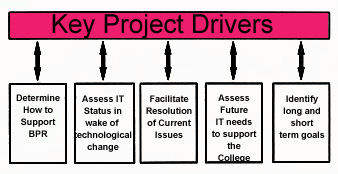
To achieve the desired results from the Information Technology Assessment, Lane decided to join with Coopers & Lybrand to perform the Lane CS Information Technology Organizational Assessment Project.
Project Approach and Plan
The primary role of Coopers and Lybrand (C&L) has been to provide an experienced third party perspective regarding the present efficiency and effectiveness of Information Technology delivery. C&L combined experiences from previous IT organizational assessments and an understanding of IT Best Practices in approaching this project. C&L's activities have taken the form of providing methodology, facilitation, and project management to perform a review of the organization alignment and delivery of products and services.
As indicated in the Key Project Drivers figure above, in addition to formulating short-term and long-term recommendations for improvement, C&L was to assist in determining if the CS information technology infrastructure could support Process Redesign at Lane. The feasibility of embarking on Process Redesign at Lane is currently being explored.
The Information Technology organizational assessment project approach has been as follows:
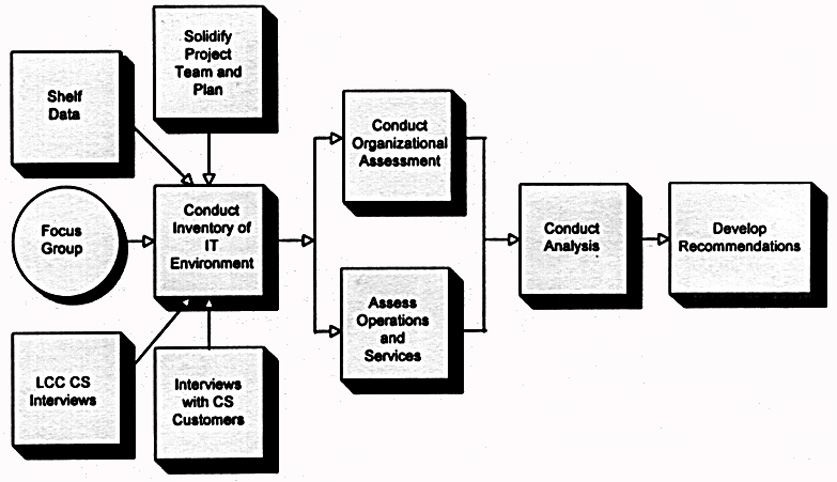
The first step in conducting the project was "Solidifying the Project Team and Plan". The process encompassed:
- Conducting a kick-off with the IT Organizational Assessment and Process Redesign teams;
- Developing Principals Guiding Analysis;
- Determining the Team Make-up: Lane-Owners, C&L-tools to guide process, and independent views/expertise to be incorporated; and
- Planning the project activities--Coordinating efforts, aligning steps and synchronizing the plan/time-line with the Process Redesign Project.
The Principals Guiding Analysis is a critical document which serves as the basis for decisions made during analysis and formulation of recommendations. These Principals became a focus for the project team when determining the 'right' way to proceed with various components of the project.
The following Principals reflect the basic goals for Information Technology at Lane.
1. Support innovation in technology throughout the College.
2. Provide services and systems that support customers.
3. Enhance customers' understanding of realistic computer systems and support technological, budgetary, human resource and organizational constraints.
4. Empower customers by transitioning power and independence to the customer groups through user-oriented tools and technology.
5. Educate customers on the responsibility that accompanies computing power and independence.
6. Determine appropriate balance between standardization and user freedom in regards to computing procedures and tools.
7. Re-deploy Computer Services Personnel to be more cost effective.
8. Explore the extent to which 'super-users' and shadow systems exist outside the Computer Services department and identify effective means of delivering technological support to all users.
During the planning component of 'Solidifying the Project Team and Plan', the project steps were planned according to the following time-frame:
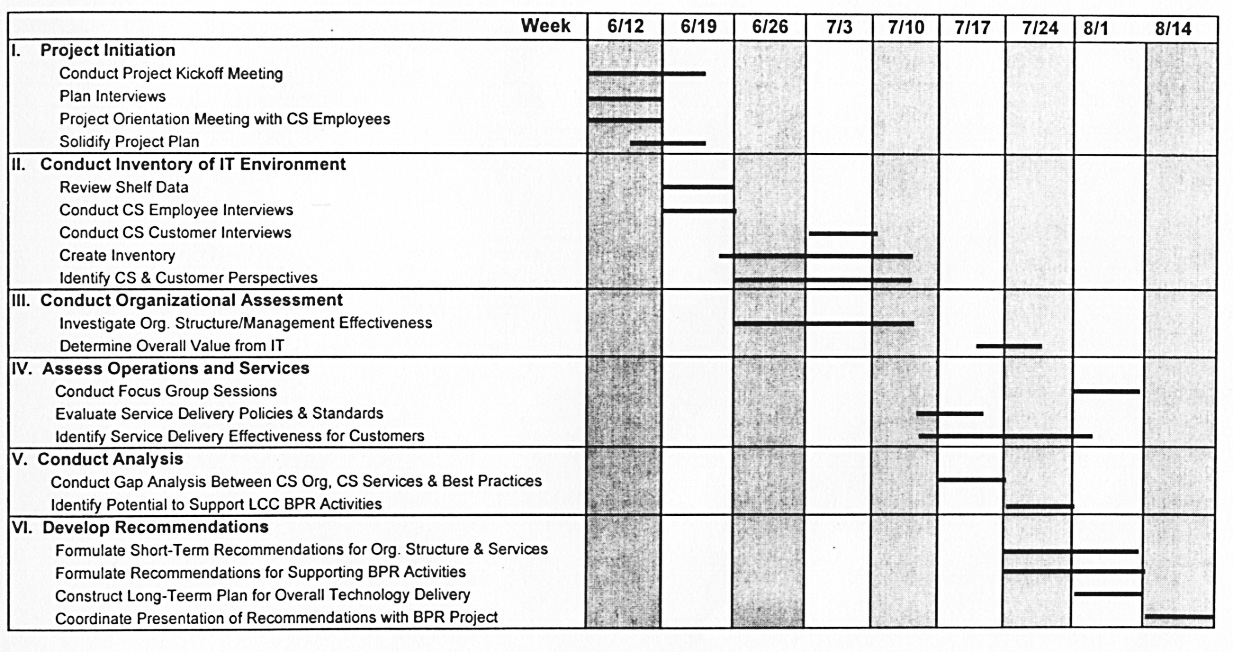
This report is structured chronologically according to the project steps. The first topic in the discussion of each project step addresses the methodology C&L employed to accomplish activities involved in that step.
To document the existing organization, the following activities were performed:
- Collection of Shelf Data
- Lane Information--To assist in understanding the big picture and provide background for analysis
- Organization Plans & Goals
- Existing Policies & Procedures
- Overviews and status of current projects and activity levels
- Lane CS Interviews
- Information gathering/recommendation collecting from people conducting the work
- Continuous open communication with employees
- CS Customer Interviews
- By definition, Services Departments exist to serve the customers
- Customer input is critical--Arranged interviews with Lane executives and campus leaders
- Executive vision for technology on the campus
- Identify views for technology delivery to campus groups (either by CS or o other campus entities)
- Focus Groups
- Identify Opportunities
- Bring together resources to discuss options
- Gain ideas as feedback into the assessment
The following table summarizes the interview and focus group activities within CS, with CS customers, and with Lane executive management.

Based on the project schedule, the interview/focus group coverage of Lane perspectives (both inside and outside of Computer Services) was extensive and provided valuable input that drove the analysis. Upon the completion of the shelf data analysis, interviews, and focus groups, C&L began the definition of the IT inventory.
The synthesis of the data collected can be viewed as an inventory of the information technology environment, which reflects the CS organization at a snapshot, and represents our understanding of environment in performing the overall assessment.
Strategy, Plans and Budgeting
Computer Services' Mission has changed dramatically over the past three to five years due to changes in the underlying technology, new roles assumed by the customers and changes in the personnel who provide vision for technology. The current strategy for CS is to perform computer-related services in response to customer requests to the best of their ability, given resource and budgetary constraints. In an attempt to be flexible and accommodate customer needs in a timely manner, the CS group has not established a mission and has not defined its strategy
The result is a lack of formal planning and definition for what the CS group seeks to accomplish over time. Services to be provided are not defined or communicated to the customer groups or the campus community. Therefore, customers make demands on CS at all levels of the organization and CS feels forced to work frantically to meet the needs of impacted/vocal instructional and administrative departments and feels guilty for not meeting the needs of the quieter 'less critical' departments.
Budgeting for information technology is not performed in a top-down manner across the campus in connection with overall Information Technology strategy . The budgeting process for central information technology is an incremental process, whereby budget adjustments are made by independent justification for new financial outlays.
Campus departments may also allocate portions budgeted moneys for information technology, independent of campus-wide IT initiatives. Since departments have different levels of funding, due to internal budget allocations or externally acquired funds (such as grants), the IT investment of each department may vary significantly. The result is a wide disparity the IT platforms, tools, and network connections across campus.
Information Technology Inventory
The information technology inventory was difficult to assess in the current environment.
As CS tries to be everything to all people and campus groups gain more power in obtaining technology independently, the process of managing the overall portfolio of applications, projects, infrastructure and services has become extremely complicated. For the most part, there are no assets tracking systems in place, nor is there an inventory of the campus desktop/tools.
Current Applications
The core campus application, CoCo Financial Package & Registration System, consumes the majority of analysis, development and systems programming time.
In addition to the mainframe applications, CS attempts to support many desk-top tools on campus. These include primary desk-top applications such as Word Perfect, Microsoft Office, Lotus Suite, various databases, graphics packages and much more, depending on personal or departmental preference.
Projects
Projects undertaken by the CS group are driven by customer requests funneled through CS managers. For programming and analysis, these projects are captured in a tracking database and overall assignment of projects is made based on this listing. It should be noted that this listing also includes 'trouble tickets'. From this standpoint, problem resolution activities, project activities and application bug fixes are intermingled.
Technology Infrastructure and Processes
The network roll-out project underway will initiate major support activities for supporting the campus technology infrastructure, which the CS department has not had to perform in the past. The roll-out was designed to be accomplished according to a pre-defined schedule of activities. Since the project initiation, the roll-out schedule has encountered timing and resource problems across campus. As a result, various groups have attempted to take ownership of the network rollout project. This has created confusion, frustration and lack of synchronization for both the CS department and the campus.
Current CS Services
Core applications design, customization, enhancement, minor development and problem solving are all functions taken on by he Programmer Analysts in meeting the needs of their customers on mainframe and network enterprise applications. Within the CS Operations Group, the systems programmer takes responsibility for transitioning changes from programming and analysis into operation on the systems. The Operators manage the print output, job submissions and limited problem resolution on the mainframe systems. The Help Desk operates, to the extent possible, to channel requests to the appropriate group. The Network Administrators are primarily involved in the Network rollout and assist in problem resolution for hardware, software and network connectivity, when available.
Computer Services and Customer Perspectives
Computer Services is extremely cognizant of the increased demands of the environment, but feels overwhelmed by the current work-load which primarily consists of 'putting out fires'. CS customers have identified key tools and technologies they envision their departments will be using as they plan for the future. They have adopted whatever means are available to quickly and adequately acquire the tools they need to meet the demands placed upon them.
While the CS customers reflect a general satisfaction with those services they do receive form CS, there exists a great backlog of user requests and an extensive list of technology needs that are not being met by CS. There is a general feeling that CS is not purposefully negligent by denying these requests, but CS is suffering from a genuine shortage of resources given their workload.
These perspectives assisted in identifying opportunities for improvement in the delivery of technology, which are further detailed in the Opportunities Listing in Appendix A.
III. ORGANIZATIONAL AND OPERATIONS/SERVICES ASSESSMENT
Methodology--Assessment of Current Organization and Operations/Services
Using the shelf data as background materials with CS and Customer Perspectives as input, C&L embarked upon the next project step. C&L began the assessment of the organization and the operations/services provided, while utilizing the knowledge of IT best practices as a guide.
Organizational Structure, Culture and Management Processes
The CS organization is aligned according to the traditional IT mainframe organizational model, separated into two groups; an Operations Group and a Programming/Analysis Group. These groups operate independently of one another and coordination between the groups is limited. Components of the group exhibit a protective approach over a 'domain of activities' and have constructed barriers to protect and control certain activities.
The mainframe alignment of activities, lack of communication, lack of coordination and tolerance for these domains has prevented the organization from effectively achieving a customer focus. As mentioned in our interfaces with people both internal and external to CS during the interview and focus group processes; the CS structure, culture and management processes are reminiscent of past management. It is only recently, with a change in CS leadership, that there has been an opportunity and 'freedom' to evolve into more efficient and effective modes of operation. It should be noted that there is recognition by the current CS managers of the inhibitors that have been imposed on the organization in the past. There is also a very strong desire to move in new and improved directions.
Human Resources Utilization
The following chart identifies the percentage of time that personnel within CS spend on various activities:
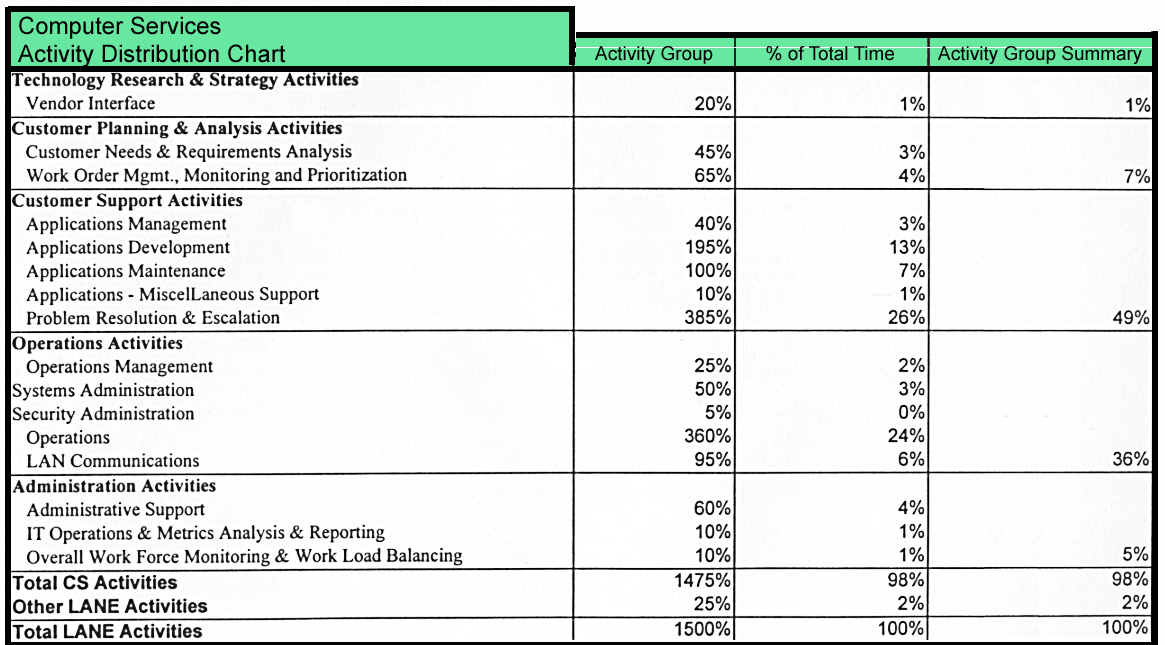
In addition to identifying activities and time spent by the CS human resources, it is important that campus-wide information technology support in pockets outside CS be identified. There are no measurements or statistics currently in to assist in estimating activities performed by these IT support resources or time allocated to those activities.
Although identification of these factors was not within the scope of this assessment, a preliminary survey was conducted to assist in gagging the overall magnitude of campus computer support outside CS. Thirteen personnel who were targeted as primarily having technology support positions outside of the CS department responded to surveys by submitting a listing of IT support related activities and time spent performing these activities. Ten of the thirteen surveys returned included percentages of time allocated to activities. These figures are captured in the column labeled 'Total Time Captured' in the chart below.
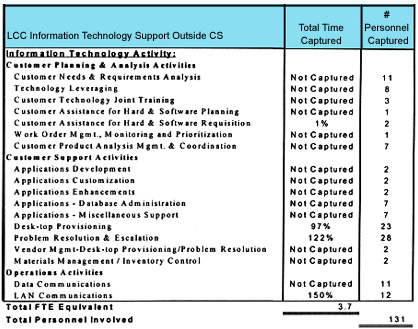
In addition to the surveys, C&L captured information during interviews regarding 'super user' resources, (i.e. human resources who are well-educated and comfortable with technology, who spend a portion of their day helping others with technology problems, leveraging technology to do jobs better, etc. for their department).
For these human resources, it is extremely difficult to identify time spent performing 'super user' activities, because they are frequently highly integrated with the remainder of their job responsibilities. For this phase of work, C&L attempted to assess the magnitude of the number of people involved in these activities. Across campus, 38 people were identified. Each of these people who participate in an activity are captured in the column labeled 'Total Personnel Captured' in the table below.
Budgeting Procedures, Budget Allocation Methodologies and Management of Operating Costs
As described in the discussion of Strategy, Plans & Budgeting, Section II. Inventory of Information Technology Environment, IT funds are not allocated according to an overall technology plan across the campus. Along with the absence of a clear strategy, there is no budgeting procedure/methodology for how moneys will be spent. This, in part, appears to be due to the change in leadership within the CS department and previously the overall budgeting process was a function performed at the exclusion of CS department managers.
CS is allocated approximately the same amount of funds each year and spends the funds in approximately the same proportion as in years past. Technology funds for special initiatives are set up separately, such as the network budget. This may have negative implications on CS's ability to be recognized as the process owner for areas in which CS has responsibility but no fiscal ownership
On campus, there is a common gap in the association of activities performed with the dollars that those activities cost the campus. No cost-benefit analysis is performed for projects or initiatives. That is apparent in CS also. CS does not 'manage' operating costs. CS 'manages' by balancing customer needs and not exceeding budgeted dollars in totality
Service Delivery Policies, Standards, Methodologies and Management
In the mode in which the CS department operates today, no service levels are established between CS and customer groups. No methodology is employed for project prioritization or expectation management on when projects or services may be delivered.
Service delivery relationships with large and high profile customers are excellent. However, service delivery with lower profile departments is practically non-existent. Some of the most successful service delivery relationships are those in which CS staff communicate directly with mangers or staff in customer departments to define needs, resolve problems, answer questions etc.
The primary form of management for service delivery is a very top-down approach that has become entrenched from many years of using this approach. This essentially required that all requests are initiated by the customers directly with the CS managers. The request is then assigned at the 'appropriate time' to a CS staff person.
A central tracking database for Computer Services has been selected and made available. However, since there has not been a priority on the creation of policies, communication, training and consensus on the use of the database, its overall effectiveness as a tool for managing service delivery has been limited. Additionally, this system houses project-related requests and applications enhancement requests as well as problem resolution requests.
Service Delivery Satisfaction and Effectiveness
The service delivery satisfaction level with most high profile customers is excellent. Lower profile departments either are extremely frustrated, because they are not heard or they have given up, after a history of receiving little or no response from CS. Some of the groups that have not been able to obtain CS services have become very active in procuring their own information technology expertise or identifying workable assistance from outside their own department or outside the college.
Specific findings on service delivery satisfaction and effectiveness are captured in the Opportunities List in Appendix A of this report.
Overall Value of information Technology Investment
In determining the overall value of information technology investment, the review and trends of metrics and other measurement statistics is key to the analysis. This holds true for moth determining the value internal to the organization as well as external through services provided from vendors.
Within CS and the other campus department supporting technology, there are no metrics or statistics defined or collected. Additionally there are no metrics or statistics defined or collected for services provided by vendors such as Omnitec and CoCo. Given this situation, we were unable to ascertain the true value of Lane's information technology investment.
It is important to note, however, that while we did not conduct a technical review of the CoCo system, through interviews and discussions with CS and campus users, it appears that the time to implement the system has been extensive. Additionally, the level of support that it requires is intensive.
IV. ANALYSIS
Methodology--Best Practices Gap Analysis
The analysis component of the assessment is intended to provide a diagnostic regarding the current state of the organization. The result of the diagnostic is a listing of opportunities that provide areas identified for improvement. This opportunities list, in combination with the data-gathering accomplished to date, serves as the background for proceeding with organizational alignment and staffing, process improvement and enhanced definition of products and services. The work products produced on behalf of these activities include:
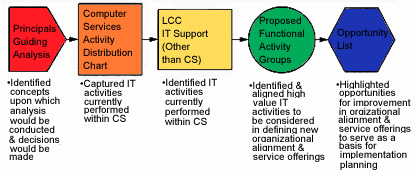
Ability to Support Existing Environment
In comparing Lane to Best Practices Organizations, it is critical to take a step back and consider what IT activities are of high value to customer groups in today's environment. The following chart provides a top-level view of activities that reflect the 'Voice of the CS Customer' at Lane and that should be considered in a re-aligned IT group:
Proposed Functional Activity Groups
 

 
The following chart contains each of these functional activities in the left column, then indicates the current alignment of Lane IT activities and their proposed alignment.
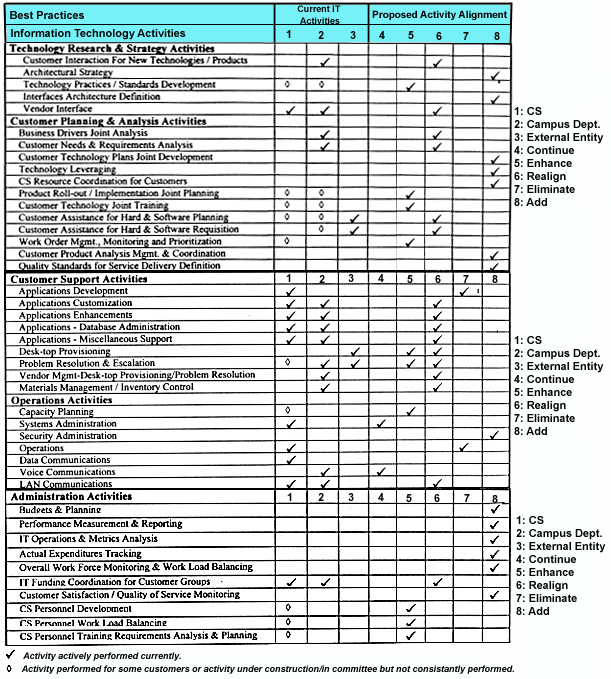
The following matrix represents critical success factors for the technological support of entity-wide process redesign and the attributes exhibited to date by CS:
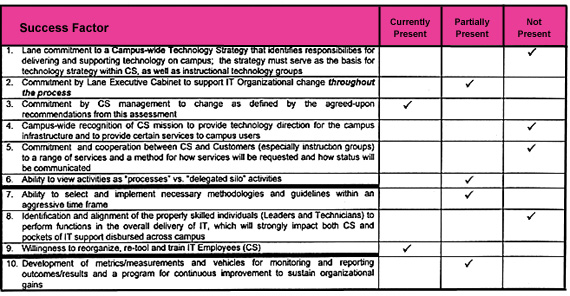
While one may view the preceding chart in a way that reflects:
- 20% of the critical success factors for process redesign are currently present;
- 40% of the critical success factors for process redesign are partially present; and
- 40% of the critical success factors for process redesign are NOT currently present:
it is important to note that with further education and awareness building through change management and knowledge transfer, we found a strong willingness to improve the Lane environment during the work performed on behalf of this project. It is expected that within the next phase of work to be conducted, this chart could change substantially.
Key components for the CS groups to support redesign will be:
- establishing and maintaining a customer focus;
- applying new technologies to support campus processes; and
- aligning IT functions to activities which are valued by customers.
V. RECOMMENDATIONS
Methodology--Formulation of Recommendations
As we conducted our study an Opportunities List of possible solutions was defined. Through constant review and discussions with various project participants, this list was continually refined over the life of the project. The Opportunity List, in addition to IT Best Practices, is the basis for all recommendations contained in this assessment.
Key components for the CS Group to effectively manage information technology as they go forward should include:
- Articulating (and committing to) a campus wide IT strategy;
- Defining and communicating IT services to be provided; and
- Aligning IT resources across campus.
Short-term Action Plan: Existing Environment
Once commitment to the proposed recommendations has been obtained, the process of designing the appropriate implementation plan (Phase II of the project) may begin.
The Opportunity List to follow reflects areas for improvement categorized as Policy, Process, Automation or Organization. Each opportunity also reflects secondary characteristics. The priority placed on each opportunity is a function of a consensus reached through discussion and review with the CS Stakeholders.
The Opportunity List, prioritized and summarized is contained in the following table. A more extensive version of the Opportunity List is contained in Appendix A of this report.
As discussed, in Sections I and III of this report, it is challenging to scope the exact level of effort for implementing the recommendations, because metrics are not identified, strategized, captured, reported or analyzed. Some of the critical short-term priorities identified on the Opportunity List include identification of the level of effort by identifying metrics, capturing the information and performing analysis against targeted goals. One approach to stratifying the activities performed within CS is to identify and classify activities as reflected on the next page.
Stratification of Information Technology Activities
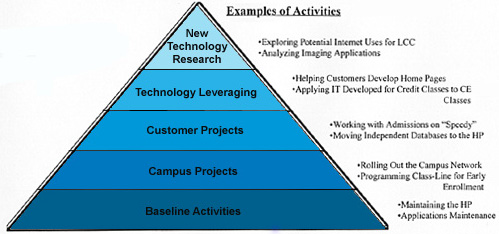
Long Term Action Plan: Existing Environment
As we reviewed the Opportunity List, the following opportunities were determined to be more long-term in nature. As the next phases of this project get underway, it will be easier to determine the exact time frame in which these opportunities should be implemented.

Specific means of Supporting Process Redesign
It is anticipated that as process redesign activities get underway, a component of each phases of project plan should include the necessary IT-related activities to support the goals and objectives of the project. Key guiding principals should include:
- Establishment and maintenance of customer focus;
- Application of new technologies to support campus processes; and
- Align IT functions to activities valued by customers.
Requirements for Implementation Phase and next Steps
The Opportunity List identifies specific changes that the customer groups require or have requested. If these required changes are not made, the customer groups will continue to circumvent Computer Services to acquire and use technology according to their needs and whims. Continuing to operate in this way might help meet immediate customer needs, but in the long run will have negative consequences for Lane. Ballooning support requirements for non-standard equipment and substantial demands for 'fire-fighting support' on a multitude of specialized applications, products and tools will occur.
Once the necessary commitment is made to proceed with the next phases of this project and each of the project's critical success factors have been reviewed and committed to, the following steps should be implemented into a plan:
- Identify Project Team participants for Implementation Planning;
- Develop a communications plan covering continual updating and support-building with executive management, internal communications to Computer Services, communications for Lane campus and communication to respond specifically to the union environment; and
- Develop a project plan that addresses the Critical Success Factors identified in the Analysis section of this report and in the Implementations Steps summarized below.
Implementation Plan DRAFT
I. Project Management Approach
Clarify Roles & Responsibilities of Phase 2 Participants
Facilitate Sessions with executive leadership to gain commitment to changes
II. Communications Plan
Executive Management
Within Computer Services
On the Lane Campus
Within the Union Environment
On-going
III. Organization & Resource Alignment
Prioritize Opportunity List items by available project resources
Assign responsibility for each opportunity plan/approach
Identify precise timeline for each opportunity plan/approach
Evaluate roles, responsibilities and job descriptions for staff
Re-align staff as processes are modified
IV. Phases Transition/Ramping Plan
Make Changes in Manageable Steps
Implement easiest and least expensive changes first
Achieve cost savings early in Transition
Establish long-term steps which provide benefits
V. Service Level and Metric (Benchmark) DevelopmentVI. Continuous Improvement Program
Please see Appendix A for a complete version of the Opportunity List
|
















